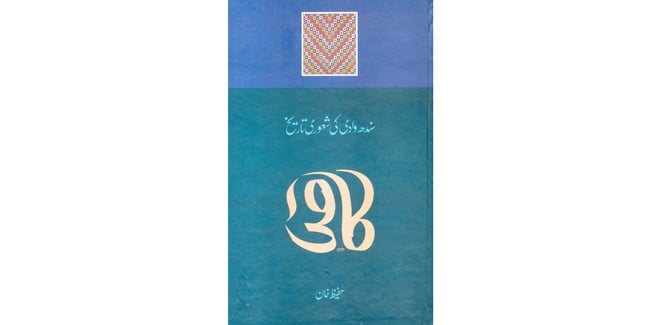

The critical canon that has developed for the evaluation of our arts including poetry does not lay much emphasis on the relationship of the poetical or the artistic forms to various ideas, intellectual and political forces extant at the time of their creation. It is considered that in an eternal battle of good and evil, the creative effort decries and shuns the conditions that gave birth to it.
Hafeez Khan has attempted to locate the critical canons within the challenges that were being faced by the artistes/poets in the times that they were living. Their coming to terms with the reality of these impediments was expressed in the ceaseless effort of their creative output.
In most of our genres of literature, like many of the forms in music, it was difficult to ascribe the name to a definite origin. Kaafi, too, both as a form of music and literature defied any answer to the innocent query as to what was meant by kaafi. Hafeez Khan has taken as deep a dive as possible to fish out the pearl from the bottom of the ocean and brought to the surface some precious stuff to describe what it looked like, what it was made of and what was its worth. But till the very end he has no ready answer as to how the word kaafi got to be associated with the form of poetry and music over these many centuries.
In the process he discovered different reasons that have been ascribed for the naming of a poetical and musical form. The next challenge was to trace it to its origin in an attempt to lay the finger on exactly what was meant in the early days by those who chose this form over all others. It was not easy but embedded in a number of extrapolations and only a far-fetched approach seemed valid to put a definite date on naming a form in the mists of history.
Rather than tunnel into the labyrinths of its origins and discover the pristine form of kaafi in its poetical form (the book is primarily about kaafi as a form of poetry, its association with music and singing has been mentioned in passing and not taken as the focal point) this took many formal shapes and defied being pinned down to any particular structure or theme. So Khan was at liberty to deduce that the poetical form and the sensibility expressed in the kaafi over centuries was in response to the changing objective conditions of the regions now known as Punjab and Sindh.
In terms of its theme too, kaafi most of all has defied being stuffed into a generic mould that has been coined for poets and poetry and what was being expressed in it. The poet known as sufi, what was being expressed in poetry tasawwaf and the rest laid to rest by arriving at some golden mean between haqiqat and majaz was not favoured by Hafeez Khan for he has not placed poetry on the shelf by just labelling it as a generic unchanging form with reference to a patent theme. He is rather more concerned with what was being expressed in the poems, and how it was reflected as the expression of a certain sensibility at a certain time.
So kaafi through history was a parallel reading of history, a delineation of the worldview that evolved in this part of the world. In its broadest dimension it had similarities with other artistic forms but primarily by giving it a local habitation and a name the sequence of this parallel narrative was firmly rooted.
Many scholars have their own take on its origins. For Dr Maher Abdul Haq there are 35 forms of kaafi, while for Sadeeq Tahir it is a derivation of the Arabic word Qawafi. Akhund Rab Dano stressed that it is a variation of kafoo which means equal or balanced. For Dr Nabi Buksh Baloch it is derived from the Arabic qafita, which became kaafi in Sindhi. Over time musical form remained kaafi while the poetical form became kaani.
According to Asif Khan, only a poetical form which has an asthai is qualified to be called a kaafi and by asthai he means a verse repeated after every stanza, something like a refrain. According to Mohan Singh Dewana, the form kaafi was first creatively used by Guru Nanak in the 15th century while for some it was first used in the 8th century. Mirza Mueen Ahmed too thought so but the opinion of most scholars and critics is that it was a product of the 15th and 16th century and its most finished form was expressed in the poetry of Shah Hussain. Being a product of the confluence of many languages like Punjabi, Multani and of the Doaba, it seemingly matured in the above period.
Kaafi is the representative expression of the land that is known as the Indus Valley; a collective consciousness fails to be carved up into the current nomenclature of Punjab, Sindh, and Khyber Pakhtunkhawa. It overlaps the poetical expression of the area and thus has antecedents that went as far as the shadows of prehistory. It also reflects the parallel history as against the construct of the mainstream historical narrative. Since this parallel historical consciousness has not really been documented except in oral form, this parallel history in poetry he has traced right back to the times of the Vedas, then to the overarching wahtatul wajood with the crucial presence of the female protagonist. He has also evaluated the poetry of Riffat Abbas as carrying the seeds of that responsibility in our time.
It can be seen as a valuable addition to a proper understanding of our artistic tradition at a conscious level taking it away, and rightly so, from the ambiguity of terms like mysticism, tasawwaf, Sufism and platitudes like "ishq e haqiqi aur ishq e majazi ka haseen imtizaj."